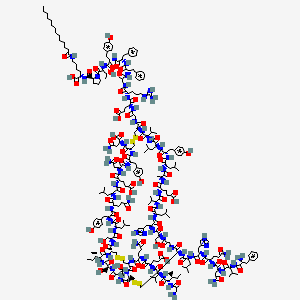



API Suppliers
0

US DMFs Filed
0

CEP/COS Certifications
0

JDMFs Filed
0
Other Certificates
0
Other Suppliers
0
0
0

USA (Orange Book)

Europe
0

Canada
0

Australia
0

South Africa
0
Uploaded Dossiers
0
U.S. Medicaid
Annual Reports
0
0
USFDA Orange Book Patents
0
USFDA Exclusivities
0
Blog #PharmaFlow
0
News
EDQM
0
USP
0
JP
0
Other Listed Suppliers
0
0


1. 12c-lys(b29)-db30i
2. B29 Tetradecanoyl Lys B30 Des Ala Insulin
3. B29-tetradecanoyl-lys-b30-des-ala-insulin
4. Basal Insulin Detemir
5. Des-(b30)-insulin, Lys(b29)-tetradecanoyl
6. Detemir, Basal Insulin
7. Detemir, Insulin
8. Insulin Detemir, Basal
9. Insulin, Tetradecanoyl-lys(b29)-des-ala(b30)
10. Insulin, Tetradecanoyllysyl(b29)-desalanyl(b30)
11. Levemir
12. Nn 304
13. Nn-304
14. Nn304
1. 169148-63-4
2. Nn-304
3. Levemir
4. Levemir Flexpen
5. Levemir Innolet
6. Levemir Insulin
7. Levemir Penfill
8. Unii-4ft78t86xv
9. Detemir
10. Insulin Detemir [usan:inn:ban]
11. Nn304
12. Nn 304
13. Insulin,detemir,human
14. 4ft78t86xv
15. Chembl2104391
16. Insulin Detemir Recombinant
17. 29b-(n6-myristoyl-l-lysine)-30b-de-l-threonineinsulin (human)
18. 29(sup B)-(n(sup 6)-myristoyl-l-lysine)-30(sup B)-de-l-threonineinsulin (human)
19. 29(sup B)-(n(sup 6)-(1-oxotetradecyl)-l-lysine)-(1(sup A)-21(sup A)),(1(sup B)-29(sup B))-insulin (human)
| Molecular Weight | 5917 g/mol |
|---|---|
| Molecular Formula | C267H402N64O76S6 |
| XLogP3 | -3.5 |
| Hydrogen Bond Donor Count | 76 |
| Hydrogen Bond Acceptor Count | 87 |
| Rotatable Bond Count | 189 |
| Exact Mass | 5914.7950469 g/mol |
| Monoisotopic Mass | 5912.7883372 g/mol |
| Topological Polar Surface Area | 2400 Ų |
| Heavy Atom Count | 413 |
| Formal Charge | 0 |
| Complexity | 14700 |
| Isotope Atom Count | 0 |
| Defined Atom Stereocenter Count | 50 |
| Undefined Atom Stereocenter Count | 0 |
| Defined Bond Stereocenter Count | 0 |
| Undefined Bond Stereocenter Count | 0 |
| Covalently Bonded Unit Count | 1 |
Insulin detemir is indicated to improve glycemic control in adults and children with diabetes mellitus.
FDA Label
Treatment of diabetes mellitus in adults, adolescents and children aged 1 year and above.
Insulin is a natural hormone produced by beta cells of the pancreas. In non-diabetic individuals, the pancreas produces a continuous supply of low levels of basal insulin along with spikes of insulin following meals. Increased insulin secretion following meals is responsible for the metabolic changes that occur as the body transitions from a postabsorptive to absorptive state. Insulin promotes cellular uptake of glucose, particularly in muscle and adipose tissues, promotes energy storage via glycogenesis, opposes catabolism of energy stores, increases DNA replication and protein synthesis by stimulating amino acid uptake by the liver, muscle and adipose tissue, and modifies the activity of numerous enzymes involved in glycogen synthesis and glycolysis. Insulin also promotes growth and is required for the actions of growth hormone (e.g. protein synthesis, cell division, DNA synthesis). Insulin detemir is a long-acting insulin analogue with a flat and predictable action profile. It is used to mimic the basal levels of insulin in diabetic individuals. The onset of action of insulin detemir is 1 to 2 hours and its duration of action is up to 24 hours. Interestingly, it has a lower affinity (30%) for the insulin receptor than human insulin.
Hypoglycemic Agents
Substances which lower blood glucose levels. (See all compounds classified as Hypoglycemic Agents.)
A10AE05
A - Alimentary tract and metabolism
A10 - Drugs used in diabetes
A10A - Insulins and analogues
A10AE - Insulins and analogues for injection, long-acting
A10AE05 - Insulin detemir
Absorption
Maximum serum concentrations are reached 6 to 8 hours following subcutaneous injection. The duration of action of insulin detemir is mediated by slowed systemic absorption of insulin detemir molecules from the injection site due to self-association of the drug molecule. When single dose of 0.5 units/kg of insulin detemir was given to adult type 1 diabetes patients, the maximum serum concentration (Cmax) was 4,641 2,299 pmol/L. Insulin detemir has a slow and prolonged absorption and a relatively constant concentration/time profile over 24 hours with no pronounced peak. The median time to maximum serum insulin concentration was 12 hours after injection. On average, serum insulin concentrations declined to baseline by approximately 24 hours. The absolute bioavailability of insulin detemir is approximately 60%.
Volume of Distribution
Insulin detemir has an apparent volume of distribution of approximately 0.1 L/kg.
Clearance
Apparent clearance (CL/F), type 1 diabetes adult patients = 3.41 1.00 L/minkg
After subcutaneous administration in patients with type 1 diabetes, insulin detemir has a terminal half-life of 5 to 7 hours depending on dose.
Insulin detemir binds to the insulin receptor (IR), a heterotetrameric protein consisting of two extracellular alpha units and two transmembrane beta units. The binding of insulin to the alpha subunit of IR stimulates the tyrosine kinase activity intrinsic to the beta subunit of the receptor. The bound receptor autophosphorylates and phosphorylates numerous intracellular substrates such as insulin receptor substrates (IRS) proteins, Cbl, APS, Shc and Gab 1. Activation of these proteins leads to the activation of downstream signalling molecules including PI3 kinase and Akt. Akt regulates the activity of glucose transporter 4 (GLUT4) and protein kinase C (PKC), both of which play critical roles in metabolism and catabolism. Insulin detemirs long duration of action appears to be a result of slow systemic absorption from the injection site and delayed distribution to target tissues. The myristic acid side chain on insulin detemir increases self-association and gives it a high binding affinity to serum albumin. These features slow its distribution into target tissues and prolong its duration of action.


